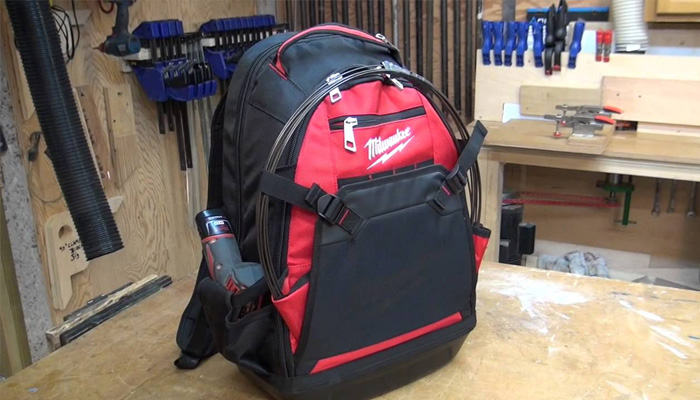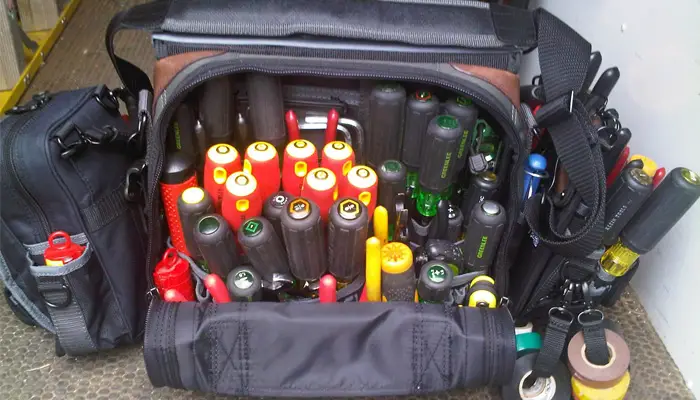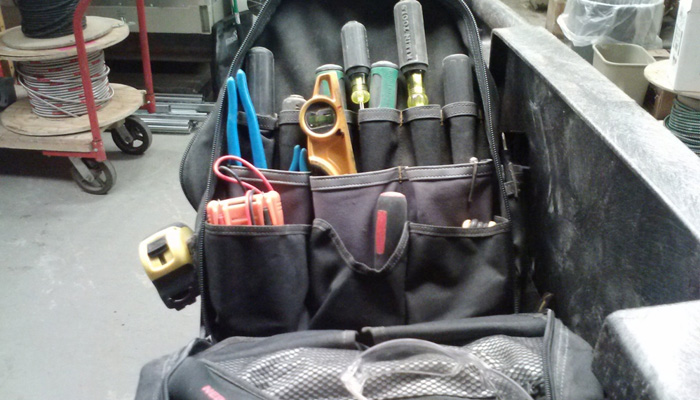A good tool backpack is a must for every handyman. No matter what your profession is, carrying tools in a traditional way will hurt your back and limit your working abilities.
The bad choice may result in an injury at the age of 45 and an early retirement. Handymen are facing many problems during the working sessions – polluted air, small space, extreme weather conditions, high voltage, hard to reach areas, complicated malfunction, work at height.
It is always good to carry the best tool backpacks, so you don’t have to, for example, get off the ladders every single time you need to take a tool.
But be warned, a bad combination of weight and tool backpack may cause you to fall from a big height and hurt yourself badly.

Criteria When Choosing The Best Tool Backpacks
There are many criteria – handyman type, size, durability and resistance, internal organization, closures, weight distribution, fabric and waterproofing, standing and opening, one-handing operating, anatomy adjustment to the shape of your back and individual needs.
Let’s take a look at all these criteria.
Handyman Type
This is definitively the most important criterion. Are you a carpenter, an electrician, a decorator, a plumber, a handyman for cooling and thermal devices, a mason, a whitesmith, a ceramist, a roofer or a universal handyman?
Every profession has different requests. Someone needs to carry a laptop wherever he goes. Some handymen simply like to work in a more traditional way, without the use of modern aids.
Size
If the description of your job involves working in a tight space, a better choice will be a backpack that is smaller and stands next to your back, without taking up too much room. Installing new clips for additional protection is also a good idea.
On the other hand, if you need to carry a lot of tools, and your job doesn’t require too much work in the heights, you may freely take a bigger backpack.
Optionally, you can adjust the best tool backpacks to your height.
Durability And Resistance
If you work on the construction yard, there is a possibility you will have to pull your backpack down the unfinished floors. There is usually extra protection on good backpacks. Its purpose is to survive being dragged. A backpack with extra protection is more durable but requires more money.
Will heavy tools rip the backpack up? That is why a backpack with extra protection is the best backpack for tools in any scenario.
Internal Organization

This is very tricky because more pockets will not necessarily mean better backpack. You need plenty of functional loops and pockets. That means you have to use wisely according to the needs of your job.
If storage sections are too big, tools will knock each other down. If storage sections are too small, you won’t be able to place a certain tool.
Loops are also an important fact, if too wide, there is a possibility your tools may not be sorted well. If too narrow, you can always customize the bag by slicing. Simply create one big loop out of two small.
Closures
It may be a bucket-style, which is very easy to open on the top. If you don’t work on height, this is a good choice. If you are working on a ladder or in a construction yard, zip closure is a better choice, so your tools won’t fall out of the backpack if you slip.
Internal zips are also a good choice for small tools. This depends on your job.
Weight Distribution
When choosing the best tool backpack, make sure to choose firm padding on the back and straps. This will prevent your backpack from digging in. A stiff back plate is also a good recommendation.
Straps – hip, chest, and waist – will give the possibility to spread the weight across your body. If your backpack doesn’t have it, you can install the straps afterward. Or simply choose a backpack with the straps, it costs more money, but it prevents your back.
Fabric And Waterproofing
It is always better to have a backpack which is 100% waterproof. Tough fastenings and great quality are needed. Unfortunately, many of the backpacks are not designed to be waterproof. Only masons and roofers mostly work outside, other types of handyman very rarely.
A rubber tray on the bottom is also a big plus if the backpack has it. You may freely put it in the mud or on the wet ground, and you don’t have to be afraid something will happen. Water will not soak it. Rubber also prevents sliding and enables better friction.
Standing And Opening

In most cases, handymen carry a backpack which stands vertically when putting on the ground. It is easier to take a particular tool that way if needed. Zips of some bags mostly go all the way to the bottom. Those types of backpacks open completely flat. Others can only be unzipped at the top of the backpack.
The flat opening is more suitable for electricians, whitesmiths or other handymen who carry a lot of small items in the internal pockets. The top opening is especially suitable for plumbers and handymen for cooling and thermal devices. Their job mostly requires carrying a few big pieces of the equipment.
One-Handed Operating
This is extremely important for electricians or decorators because they spend a lot of time on the ladder. Those two types of handymen will rather choose stiff fabric loops since there is a possibility to return and remove the kit one-handed, and another hand is needed for balance.
Plumbers are, in most cases, the fans of elasticated loops. It holds the kit more securely, however, both hands are needed to close. Plumbers are mostly on the solid ground while working, so two hands are not needed to maintain balance in most cases.
Anatomy Adjustment To The Shape Of Your Back
It is always better to choose a backpack for tools which has this possibility. Unfortunately, this feature is more present with hunting backpacks or solar backpacks. However, more expensive tool backpacks have this ability.
Individual Needs
Humans have different ways to view the world. For example, someone hates a specific color and doesn’t want a specific model. Someone simply doesn’t need a backpack with a lot of pockets and loops. Someone will ignore the specific backpack only because he hates the design. Everybody has its own style, advantages, and disadvantages.
Leave a Reply